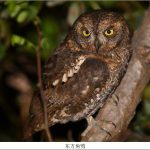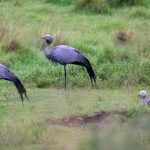
As the boreal migrants head north, breeding season for the residents and austral migrants is beginning to pick up. A friend of mine has been begging me to come over to document a nesting pair of Plumbeous Kites in her property but life has gotten in the way thus far. They’ve not wasted any time, having drifted northward from mainland South America only a few weeks ago. There are other austral migrants breeding here, however – I’ve found two separate nesting sites of the incredulous looking Swallow Tanager thus far.

A young male Swallow Tanager holding a bit of nesting material. Perhaps his first attempt at raising a family – I’ll be checking on him in a few days!
We’re still waiting on the hordes of Fork-tailed Flycatchers to truly herald the long, hot days of the tropical dry season. What I’m not looking forward to is the flurry of rare bird reports of elaenias.
The residents are also heating things up, there is an immense amount of courtship going on currently. Gift exchanges, new and fancy dress, males hot on the heels of discerning and nonchalant females – it’s all quite exciting.

A pair of Tropical Parulas courting, the male (below) closely following the female (above) as she effortlessly slipped from branch to branch.
Before the sun came up one morning I observed a pair of Channel-billed Toucans feeding in a distant tree. After feeding together for some time, the male began offering his prospective mate the gift of fruit.

I cannot verify or deny his success.
Some birds chose to sit quietly together, perhaps getting to know each other’s quirks and habits before settling down to raise a family.

Female and male White-lined Tanagers.

We observed this female Collared Trogon gesticulate inaudibly for about five minutes, keeping her eye on (presumably) a male higher up in the canopy.

Many birds are also building fresh nests, like this Bananaquit.
Trogons are fascinating birds with intriguing habits, not the least of which is their preference for termitaries to raise their young. I observed a pair of Green-backed Trogons last week sitting together and sporadically flying to a nearby termite nest, hovering briefly before returning to the perch. I managed to get one picture of both birds – but both were obscured by foliage.

The female Green-backed Trogon on an intermediate perch between the termite nest and her mate.

Some species have already fledged their young and are in the process of feeding the juveniles. This Streaked Xenops located a banquet in this decaying twig and returned numerous times to extract insects and larvae for its young waiting in the branches above.

I’m lucky in that I’m still getting lifers – a few days ago I twitched a report of Yellow-bellied Seedeaters in the hills and was not disappointed. I saw one adult male along with this young male, learning the musical ropes of this rarely seen species. The reason why they are rare is a contentious topic locally yet painfully obvious elsewhere.
The resident raptor population is not to be left out, while I was enjoying the seedeaters previously mentioned I noticed a family of Common Black Hawks riding the thermals in the valley as the morning grew warmer. Two adults and two completely boisterous juveniles. The young birds continually dive-bombed each other and their annoyed parents.

Common Black Hawks, adult and juvenile.
Even on the coast, our massive population of Laughing Gulls – the largest aggregation of the species in the region – is mostly made up of birds in magnificent breeding plumage. Tons of fishy gifts, lipstick and laughter. Sounds like a party.

Laughing Gull
For me, it’s impossible to not get caught up in the avian social drama unfolding and evolving continuously. What about you? What birds have you been seeing ushering in the next generation?











Gorgeous photos!
Thanks, Nick!